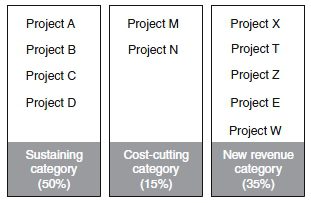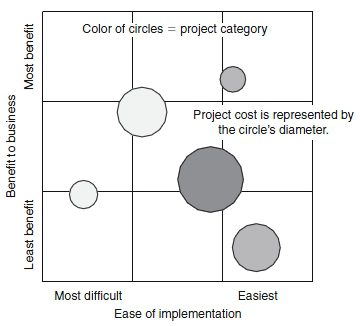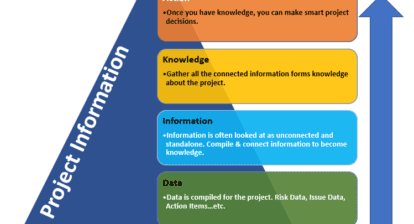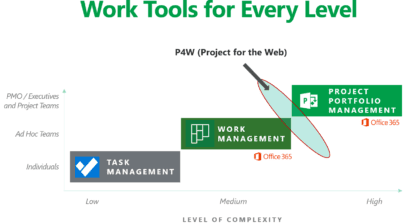Projects fulfill a number of purposes within an organization. The categories within a portfolio make clear which purposes the projects serve. Examples include mandatory growth, cost-cutting, and sustaining projects. For example, a sustaining project could include preventive maintenance projects for current manufacturing equipment. Growth versus cost- cutting distinguishes projects that generate new revenue from projects that make the operation more efficient. Strategic goals also become portfolio categories when multiple projects become tied to each goal.
Establishing portfolio categories provides a framework for allocating resources and risk. Just as a 401(k) establishes investment proportions, such as 40 percent fixed income and 60 percent equities, a project portfolio uses the categories to allocate the organization’s cash and personnel at a high level (see Figure 1).

Figure 1. A project portfolio. A portfolio is made up of different categories, each of which can represent a different proportion of the overall portfolio. Within each category, projects are ranked.
Whenever the steering committee reviews the portfolio, the first focus should be to review the categories and the allocation among the categories to ensure that they continue to reflect the goals of the organization’s strategy. Due to changing contextual conditions, this may require altering weights, recalculating scores, and adjusting the portfolio accordingly.
PPM Information Supports Decisions
Project portfolio management is intended to be a data-driven decision process. A critical success factor for PPM is the capability to provide, as one PMO manager called it, “a single source of truth.” Although PPM decisions will always be subjective — even political — accurate information that everyone can trust increases the quality of the discussions and decisions.
PPM information generally consists of a list of all active and proposed projects, specific information for each project, and information about the limited resources that are being spread across the projects. The information supports both portfolio selection and portfolio monitoring.
The list of all projects is critical during selection to avoid redundant projects. Portfolio monitoring information tends to include the following for every active project:
- The approved budget and the current forecast cost at completion.
- The approved completion date and the current forecast completion data.
- Updates to the criteria used for portfolio selection that describe strategic fit, risk, and return on investment.
In addition to project-specific information, PPM typically requires an understanding of resource constraints that will affect the portfolio. At a minimum, this would include the cash flow available to fund proj ects. Recent technology advances also make it easier and more practical to include personnel availability forecasts. These forecasts prevent a firm or department from taking on more projects than its staff can handle, while scheduling projects so that all staff members are kept busy.
Project Selection and Prioritization
It has been said that you can’t compare apples and oranges. It is a saying that characterizes a choice between two options with different benefits and disadvantages. Choosing between potential projects frequently presents that same dilemma.
A seasoned executive can justifiably rely on her or his intuition and judgment to choose between two projects, even if they are an apple and an orange. That won’t work for project portfolios. The range of projects that confront a portfolio steering committee can turn the “apples versus oranges” dilemma into a fruit salad. Consistent proposals and selection criteria put a decision-making framework in place.
Stakeholders Agree on Selection Criteria
Work with the steering committee to gain agreement on weighting the categories within the portfolio. Within each category, quantitative and qualitative criteria are used for ranking projects. Although criteria may change between categories, some factors are common to most portfolio ranking processes:
Mandatory. Certain projects must be done, such as those needed for Sarbanes- Oxley compliance. If a project is mandatory, the question is not whether to do it, but whether the scope can be minimized.
Quantitative benefits versus cost comparison. This comparison is made using a return on investment formula that quantifies the expected benefit (increased revenue or decreased costs) with the expected project and life cycle costs. Using a consistent quantitative formula makes it possible to compare projects that are otherwise quite different.
Subjective. Factors such as strategic fit, customer satisfaction, and risk should all play a role. These factors can be assigned a score — such as 1 to 5 — to make them easier to compare.
External. What factors outside your control — such as exchange rate or market trends — should affect project selection A car manufacturer that is comparing potential new models might have a variable that reflects the effect of the price of gasoline on the demand for proposed vehicles.
Not all of these factors will count equally, which is part of the “apples versus oranges” challenge. Once the criteria are chosen, it is common to use a weighting formula that recognizes the relative importance of each factor.
One goal of creating a project selection model is to gain the approval of the sponsors for the portfolio and minimize resistance by other stakeholders. Establishing the criteria exposes the different values executives use to choose projects. Expect the process to be somewhat contentious, but the give-and-take required to refine the criteria will build support for the PPM process.
Create Portfolio Options and Select the Best
All together, the common factors and weighting formulas provide the framework for making quantitative comparisons among projects. PPM analysis usually includes tables and graphics that help illustrate the variables. Figure 2 shows a classic portfolio bubble chart. These charts are able to show four variables by using the four variables by using the vertical and horizontal axis and the size and color of the bubbles.

Figure 2. A portfolio bubble chart.
As long as selection factors are subjective, the selection process is far more than just a math problem worked out on a spreadsheet. The categories and rankings are models that allow us to adjust our variables to consider different scenarios. As you adjust these variables, also watch the effect on resource allocation and expenditures.
Personnel Capacity Management Is a Major Benefit of PPM
PPM information systems are increasingly able to tie personnel requirements to projects, which allows personnel utilization to be a factor in project selection. Integrating personnel limitations into the process yields three major benefits.
- Avoid overloading the people who deliver the projects. When people spread their time between ongoing operations and multiple projects, it is easy to assign them far more work than they can realistically accomplish. PPM systems promote visibility into resource loading.
- Available skills can change priority ranking. Money is fungible, but people are not. If one project is taking the majority of electrical engineers, another equally high-priority project that also needs electrical engineers might have to be put on hold while a lower-priority project that uses available mechanical engineers gets the green light.
- Tie staffing plans to strategic goals. The projects in a portfolio line up to strategic goals. Staffing can be projected based on the forecasted projects, identifying particular skill areas that need to grow or that are overstaffed. With this resource forecast, it can be possible to increase or decrease staffing at a more deliberate rate that is more cost-effective.
Whether it’s cash flow or personnel, organizations are faced with limited resources. When a PPM system sheds light on the resource constraints, the true cost of pet projects becomes more evident as we see the other projects that won’t be performed.

This article is excerpted from the new book, The Fast Forward MBA in Project Management, 4th Edition. Copyright 2011. This material is used by permission of John Wiley & Sons, Inc.







